Floor and Crawl Space Insulation
When and Where to Insulate
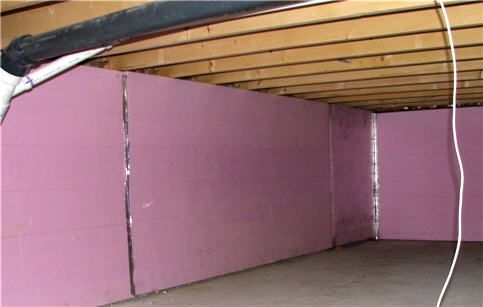
All floor spaces over unheated and minimally heated spaces should be insulated. This includes:
- crawl spaces
- garages
- cantilevered floors
- bay windows
- porches
Cement slab on grade floors should be insulated around the perimeter with rigid foam insulation suitable for direct burial to a depth of at least 2 feet.

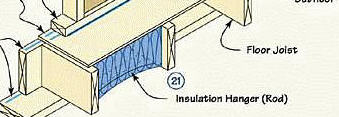 At a minimum, insulate the floor band joist. The Band Joist, also known as the Rim Joist, is the outside perimeter around the floor joists. (See Graphic) The band joist is an easy place to insulate because it is open and accessible. It is insulated by cutting short lengths of R-19 fiberglass batts and stuffing between each floor joist, before finishing the basement ceiling.
At a minimum, insulate the floor band joist. The Band Joist, also known as the Rim Joist, is the outside perimeter around the floor joists. (See Graphic) The band joist is an easy place to insulate because it is open and accessible. It is insulated by cutting short lengths of R-19 fiberglass batts and stuffing between each floor joist, before finishing the basement ceiling.
| Before adding insulation to the band joist area, be sure to air seal it also. If only insulation is added, air may still blow around and through the insulation. | 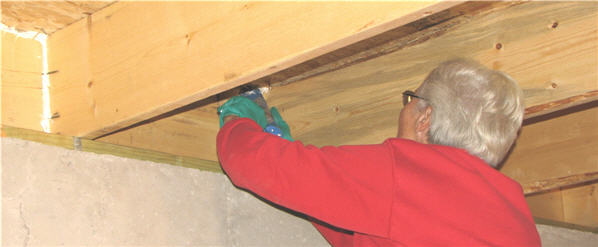 |
| This band joist has been sealed with foil-faced rigid foam insulation caulked on all edges and then fiberglass added for additional R-value | 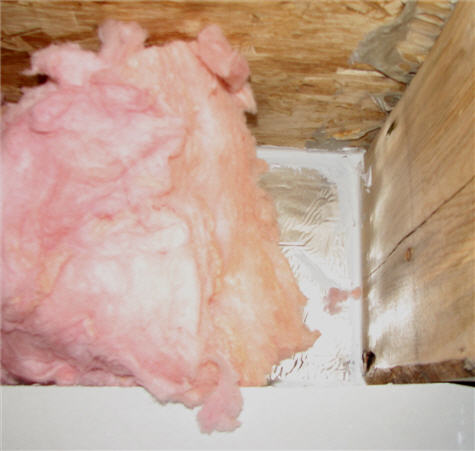 |
| This IR image shows cold air leaking through a band joist that is not air-sealed. | 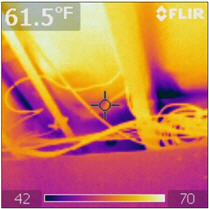 |
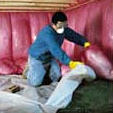 If there are heating ducts and/or water pipes in the crawl space, the perimeter stem wall should be insulated instead of the floor joists.
If there are heating ducts and/or water pipes in the crawl space, the perimeter stem wall should be insulated instead of the floor joists.
The use of vapor barriers in floors is controversial. The general rule for vapor barriers is to have them on the winter warm side of the insulation. However, it is virtually impossible to install an effective vapor barrier on the top side of the insulation. Also, in most cases, there is more vapor pressure coming from a damp crawl space than from the heated space. Kraft paper faced insulation installed by stapling only the kraft paper to the floor joists, will probably fall down over time. Therefore, most of the time un-faced insulation is installed with wire supports. A vapor barrier should be installed on the floor of the crawl space.
Crawl space ventilation is also controversial. Many Codes require crawl spaces to be ventilated with the theory that they will dry out during the summer months. However, when hot humid air enters a cooler crawl space, there is likely to be MORE moisture build-up than drying. Therefore, when deciding if or when to ventilate, consider these variables and the actual conditions at the time. It is becoming more common that crawlspaces remain unvented year-round.
Insulation Options
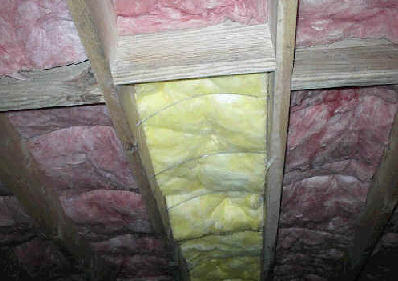
Retrofit
If there is access, R-19 fiberglass batt insulation can be placed between the floor joists or along the stem walls (see above).
If there is no access but the floor joists are enclosed, such as a floor over a garage with a finished ceiling, cellulose or fiberglass can be blown between the floor joists.
New Construction
Insulate all framed areas with at least R-19 fiberglass batts before they are concealed.
Insulate all concrete areas on the exterior with at least 2″ of rigid foam board. (See Graphic above for insulation installation options.)
More Information
Open a PDF from DOE on Floor and Crawl Space Insulation
Source: Text Bob Fegan 12/2008; Photos by Bob Fegan; graphic images from DOE and Owens Corning web sites 9/2003;
© 2008 Energy Solutions Center400 N. Capitol Street NWWashington, DC 20001 All rights reserved. Legal Contact our webmaster
